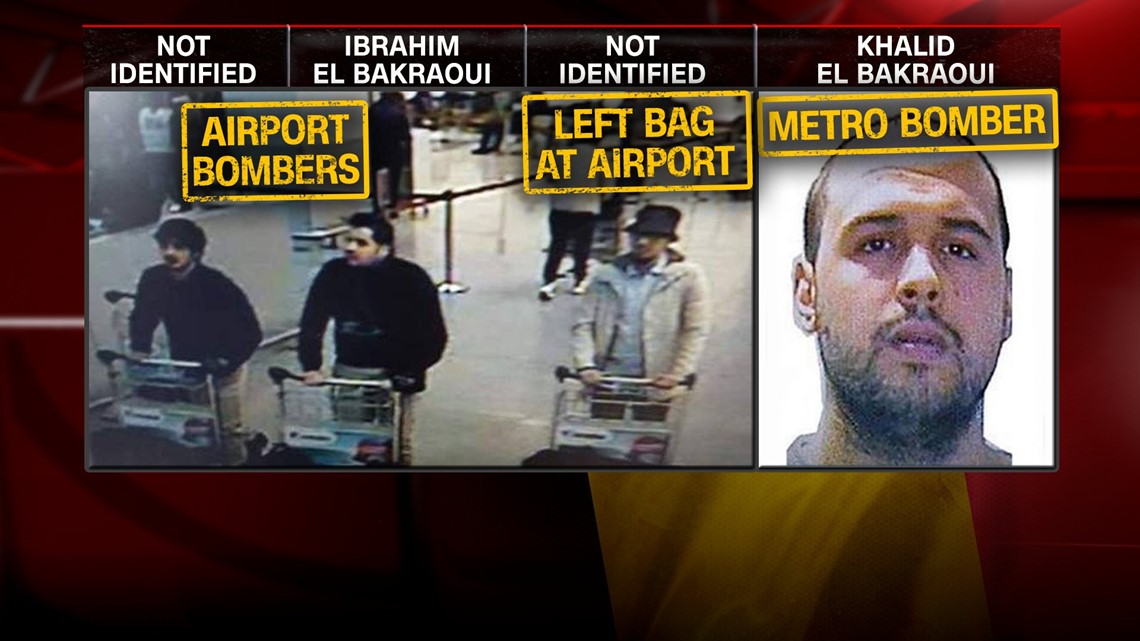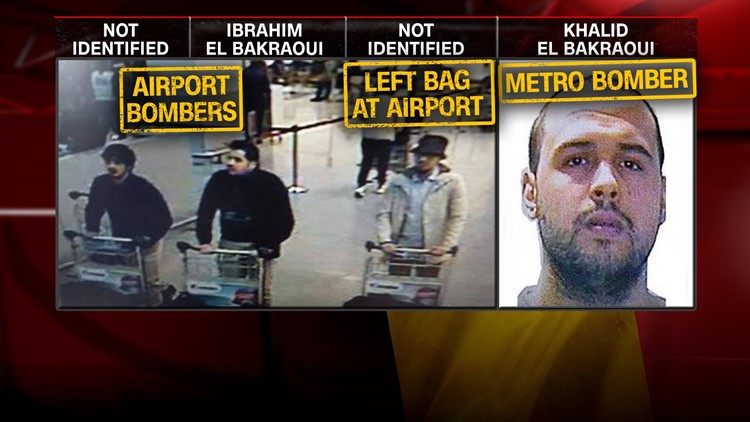BRUSSELS, Belgium — Two brothers blew themselves up during bloody terrorist attacks that rocked Belgium’s capital and, in fact, all of Europe — and the nightmare isn’t over, with at least one other attacker still on the loose.
Belgian federal prosecutor Frederic Van Leeuw identified Ibrahim El Bakraoui as one of two suicide bombers at the Brussels airport and his brother, Khalid El Bakraoui, as the man behind a deadly suicide blast about an hour later on a train near the Maelbeek metro station.
There has been no official word yet on the identity of two other men seen, alongside Ibrahim El Bakraoui, pushing luggage carts through the Brussels Airport in a photo released by authorities Tuesday.


One of those unidentified men is a presumed suicide bomber himself. The other, dressed in light-coloring clothing and a hat, is thought to have placed a bomb at the airport and then left. He’s now on the run, according to Van Leeuw.
While two explosives went off within 37 seconds of each other shortly before 8 a.m., this third bomb — described as the “heaviest” by Van Leeuw — did not, instead being detonated by authorities later in a controlled explosion.
Two people were arrested Tuesday in connection with the attacks — one in Schaerbeek and the other in Haren — though one of them was released later that day, Van Leeuw said.
Another person was detained Wednesday, according to Belgian state broadcaster RTBF. That said, officials indicated this person is not the third airport suspect — the man in light-colored clothing — seen in the released photograph. Two U.S. officials said they believe the man planned all along to plant the bomb and leave.
Wherever he is now, with Belgium still at its highest security alert level, Belgians face continuing danger even as they mourn the 31 killed and 270 wounded in Tuesday’s attacks.
As Belgian counterterrorism official Paul Van Tigchelt said Wednesday, “There are still a number of people possibly involved in the attacks still in our country … who still pose a threat.”
Links to Paris attacks?
The more authorities dig, the deeper the connections appear to be between Tuesday’s attacks in Brussels and those four months ago in Paris, where 130 people died in a terrorist massacre inside a concert hall, in cafes and restaurants and on the city’s streets.
Investigators know that several of the Paris attackers had spent time in Belgium. One of them was Salah Abdeslam, who has been identified as the lone member of the core group of eight Paris attackers to survive.
Abdeslam was captured following a gun-battle with police Friday in Brussels. Belgian officials later said that the 26-year-old may have been helping plan new attacks at the time of his capture.
Investigators believe Abdeslam likely planned to be part of an attack orchestrated by the same ISIS cell that carried out Tuesday’s attacks in Brussels, a senior Belgian counter-terrorism official told CNN’s Paul Cruickshank.
The Brussels attackers likely accelerated their plans when Belgian police discovered Abdeslam’s hideout, investigators believe. The Belgium-born French citizen is thought to have eluded authorities — while Mohammed Belkaid covered for him until being killed by a Belgian police sniper — that first time, only to be caught a few days later.
That initial March 15 raid, in the southern Brussels district of Forest, was on a residence that one of the Bakraoui brothers rented using false identity papers, said a senior Belgian counterterrorism official.
A different Belgian security source said that Khalid El Bakraoui, specifically, rented that apartment and that he and his brother had ties to the November 13 carnage in Paris.
Interpol had a standing “red notice” for Khalid, the subway bomber, that noted Belgian authorities wanted him in connection with terrorism. A similar notice — which signals police worldwide that someone is wanted but isn’t equal to an arrest warrant — is out for Najim Laachraoui, who authorities publicly identified on Monday as being a suspect in the Paris attacks.
Speaking about the Bakraoui brothers, Van Leeuw said, “These two deceased suicide bombers had lengthy criminal records but (were) not linked to terrorism.”
The Turkish presidency’s office noted Wednesday that authorities captured Ibrahim El Bakraoui in June 2015 and flagged him to Belgian authorities shortly thereafter.
It’s not clear how seriously Belgian officials took his case, though one expert thinks that having the Bakraouis’ names public now should help with the investigation.
“You can start basically peeling back the onion,” said Cedric Leighton, a CNN military analyst and the former deputy director for the Joint Chiefs of Staff. “Hopefully what it will do is it will speed up the process by which they can actually look at all of the different elements of this and possibly roll up some more suspects.”
Airport partially reopens
Cargo and private flights were once again allowed Wednesday in and out of the Brussels Airport, though commercial passenger flights won’t resume until at least Saturday, the airport tweeted.
A makeshift morgue has been set up at the airport while officials try to identify those killed, Red Cross spokeswoman An Luyten told CNN. Figuring out the names of the dead, the missing and the injured is made difficult by the fact that they come from about 40 nationalities, Belgian Foreign Ministry spokesman Didier Vanderhasselt said.
“Very slowly, we are getting information about victims,” Vanderhasselt said.
Taxi driver’s account is key clue
Meanwhile, investigators are searching for more clues thanks in part to a taxi driver who told investigators he drove the three men pictured pushing the luggage carts to the airport.
Once there, the taxi driver told authorities his passengers would not allow him to unload their suitcases from the cab. He also led investigators to where he picked the three men up in the northeast Brussels area of Schaerbeek — which, according to officials, led to a police raid there.
Investigators found chemical products and an ISIS flag during a house search in Schaerbeek, the federal prosecutor’s office said in a statement.
And on Wednesday, Van Leeuw revealed that police found the will of Ibrahim El Bakraoui on a computer in a trash can on Max Ross Street in Schaerbeek.
The will indicated Bakraoui “needs to rush,” claiming if he waits too long he’d end up “next to him in prison” — though the prosecutor didn’t reveal who this incarcerated “him” was.
According to the document, Bakraoui “no longer feels safe” — something he allegedly wrote before setting off explosives that caused death, panic and massive injuries at Belgium’s biggest airport.
Putting the pieces together
When the driver picked up Bakraoui and the two others in Schaerbeek, they had too many suitcases to fit in the cab, according to the Belgian counter-terror official.
Does that mean the attack could have been worse, had they brought more explosives? It’s possible; at the least, what authorities found at the same Schaerbeek residence where the men were picked up shows they had a lot more firepower they’ll now never use.
Van Leeuw, the federal prosecutor, noted authorities found 15 kilograms of the explosive TATP and screws among the bomb-making materials there.
French prosecutors have said that the bombs used in the November Paris attacks — which, like those in Brussels, ISIS claimed responsibility for — were also made from TATP, which stands for triacetone triperoxide.
“Such bombs have been a signature of jihadist terrorists in the West for more than a decade because the materials are so easy to acquire, unlike military-grade explosives, which are tightly controlled in much of the West,” CNN National Security Analyst Peter Bergen said.
TATP-based bombs require technical know-how and bulk purchases of hydrogen peroxide or hair bleach. That helps authorities narrow down potential bomb-making suspects, because making the explosives can sometimes bleach hair. So authorities can identify bomb-makers in part by recognizing unusually bleached hair or asking sellers to report any suspiciously large purchases of hydrogen peroxide.
Intelligence sharing will be very important in the days to come, says Steve Moore, a CNN law enforcement contributor.
“They obviously have some information. They don’t know if they’re looking at one cell or a series of cells. And so now it’s time to get all around at the same table and exchange information,” he said. “If you can get them all to use the same currency, I cannot believe that you can’t get them all to share intelligence.”



